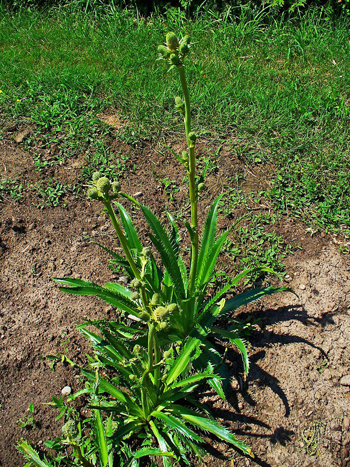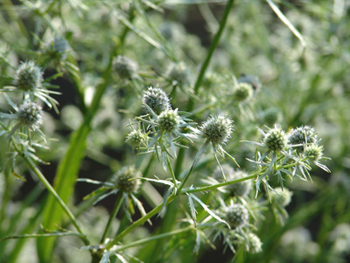Contents:
Common Names | Parts Usually Used | Plant(s) & Culture | Where Found | Medicinal Properties
Legends, Myths and Stories | Uses | Formulas or Dosages | Bibliography
Scientific Names

- Eryngium aquaticum L.
- Umbelliferae
- Umbel family
Common Names
- Button snakeroot
- Corn snakeroot
- Rattlesnake’s master
- Rattlesnake weed
Parts Usually Used
Root
Back to Top

Description of Plant(s) and Culture
Water eryngo is a native perennial herb; its glaucous tuberous root sends up a simple stem, 1-5 feet in height. The long, taper-pointed leaves, 1 to 2 feet in length and 1/2 to 1 inch wide are net-veined and entire or remotely toothed. Blooming in August, the small, whitish flowers grow in spikes subtended by a whorl of bracts. The root is tuberous, aromatic and of a sweet acrid taste, resembling the parsnip.
Back to Top
Where Found
Grows in swamps and low wetlands from New Jersey to Georgia; west to Texas, Missouri and Minnesota.
Back to Top
Medicinal Properties
Diaphoretic, diuretic, emetic, expectorant, stimulant
Back to Top
Legends, Myths and Stories
Rattlesnake master is used as a common name for Virginia snakeroot (E. aquaticum) and for E. yuccifolium, and for False Aloe (Manfreda virginica) of the Amaryllis family.
There are about 220 species in the genus, of which about 22 are found in North America.
Back to Top
Uses
The root is very useful when chewed to promote the flow of saliva and thus aids digestion. In large doses, it is an emetic. It has been a remedy for chronic laryngitis and bronchitis, dropsy, gonorrhea, gleet, stones, inflammations of the sexual and urinary organs, and impotence. Native Americans used it as an emetic and diuretic, and the infusion to reduce fevers. It is a good substitute for Senega snakeroot (Polygala senega). Used internally and externally, it cures the bite of snakes and insects and wounds.
Back to Top
Formulas or Dosages
Infusion: use 1 heaping tsp. root to 1 pint boiling water. Take 1 tbsp. 2 to 4 times per day.
Tincture: a dose is from 10 to 20 drops.
Back to Top
Bibliography
![]() American Folk Medicine
American Folk Medicine, by Clarence Meyer, Meyerbooks, publisher, PO Box 427, Glenwood, Illinois 60425, 1973
![]() Culpeper’s Complete Herbal & English Physician: Updated With 117 Modern Herbs
Culpeper’s Complete Herbal & English Physician: Updated With 117 Modern Herbs, by Nicholas Culpeper, Meyerbooks, publisher, PO Box 427, Glenwood, Illinois 60425, 1990, (reprint of 1814)
![]() Eastern/Central Medicinal Plants
Eastern/Central Medicinal Plants, by Steven Foster and James A. Duke., Houghton Mifflin Company, 215 Park Avenue South, New York, NY 10000
![]() The Herb Book
The Herb Book, by John Lust, Bantam Books, 666 Fifth Avenue, New York, NY. copyright 1974.
![]() Indian Herbalogy of North America
Indian Herbalogy of North America, by Alma R. Hutchens, Shambala Publications, Inc., Horticultural Hall, 300 Massachusetts Avenue, Boston, Massachusetts 02115, 1973
![]() Webster’s New World Dictionary
Webster’s New World Dictionary, Third College Edition, Victoria Neufeldt, Editor in Chief, New World Dictionaries: A Division of Simon & Schuster, Inc., 15 Columbus Circle, New York, NY 10023
